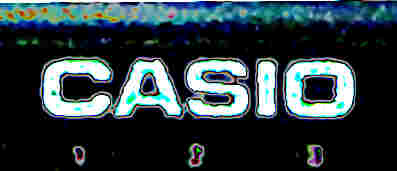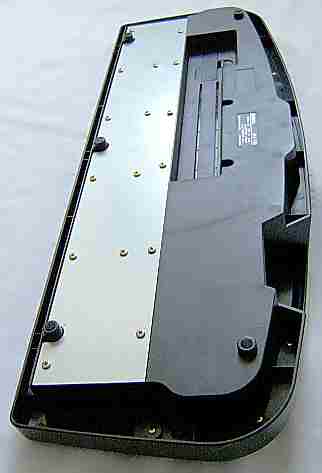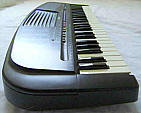 |
 |
keyboard with interesting lo-fi wavetable sounds
& percussion |
|
|
This keyboard from 1993 (embossed case date) is the closest relative
of Casio's SA-series that
has real (not fixed key) accompaniment and 49 keys.
The 100 preset sound engine resembles Casio
SA-1 (sounds see there)
although some sounds are different and partly sound worse, but you can
toggle here the 2nd suboscillator of each sound with the "tone bank" button,
which doubles as well the count of available sounds as the low polyphony.
Some sounds change internally (e.g. "funky clavi" gets an echo with active
2nd suboscillator), so this is also a sound control.
The 100 preset rhythms use very grainy low- res percussion samples those
are partly even looped and nice for tekkno things. There are even various
manual keyboard drum kit modes (although no programmable rhythm or the
like). Unfortunately the accompaniment accepts only standard establishment
chords and permits only monophonic melody play (or 2 notes with 2nd suboscillator
off).
This instrument was released earlier as Casio MA-120 (with black
text panel background and different demo "Together Forever" by Rick Astley,
seen on YouTube).
main features:
-
49 midsize keys
-
built-in speaker (only 10cm, bassless with treble resonance)
-
main voice polyphony up to 8 notes (only 7 with rhythm, 2 with accompaniment,
sounds with active suboscillator halve polyphony)
-
100 preset sounds {piano, elec piano, funky clavi, harpsichord, elec organ,
jazz organ, pipe organ, church organ, street organ, accordion, samba whistle,
whistle, quena, flute, flute-vib, ocarina, bagpipe, harmonica, chorus,
brass-strings, warm strings, strings, violin, violin-vib, cello, elec guitar,
jazz guitar, mute guitar, metal guitar, slap bass, elec bass, wood bass,
snare bass, mandolin, banjo, sitar, ukulele, harp, taishokoto, shamisen,
brass ens, warm brass, trumpet, tuba, brass hit, wind ens, english horn,
oboe, bassoon, clarinet, vibraphone, marimba, church bells, bells, tom,
rock drum, swing drum, triangle, sample percussion, matsuri, synth-celesta,
synth-clavi, synth-accordion, synth-piano, synth-brass, synth-reed, synth-lead,
synth-guitar, synth-strings, synth-brass, glass harmonica, fantasy, waw
voice, twinkle echo, metal lead, plunk extend, cosmic dance, cathedral,
pop lead, pearl drop, airplane, ambulance, insect, emergency alarm, laser
beam, cosmic sound, telephone, car horn, computer sound, motorcycle, bass/vibraphone,
bass/piano, bass/trumpet, bass/synth-lead, bass/elec organ, strings/brass,
chorus/bells, brass/synth-reed, piano/flute, strings/oboe} (resembling
Casio
SA-1, selected by 2 digit numbers)
-
100 preset rhythms {rock 1..2, hard rock 1..3, heavy metal 1..2, 8 beat
1..3, 16 beat 1..8, latin 16 beat 1..2, 70's disco, euro-beat 1..4, hip-hop
1..3, techno-pop 1..2, funk 1..10, pops 1..5, 30's pops, 60's pops 1..4,
rock'n'roll 1..3, mersey beat, slow rock 1..3, doo-wop, rhythm & blues,
blues, swing 1..4, big band 1..3, jazz waltz, tap-dance beat, boogie-woogie,
samba 1..2, bossa nova 1..2, tango, beguine, mambo, rhumba, cha-cha-cha,
habanera, reggae 1..2, salsa 1..3, folklore 1..2, country, enka, polka,
galop 1..2, march 1..2, waltz 1..2, classical, elec classical, street organ,
koto}
-
cipher buttons {"0".."9"} to select preset sounds & rhythms
-
"poly/texture" function (disables 2nd suboscillator)
-
volume slider (5 steps)
-
accompaniment volume slider (with rhythm, 5 steps, steals bit resolution)
-
single finger & fingered accompaniment (only with rhythm, no manual
organ chord mode, only standard chords)
-
fill-in button
-
tempo +/- buttons (44 steps)
-
wavetable sound generator with sounds based on 2 mixed low-res loop samples
and FM variants with independent, partly very complex algorithmic pitch
& volume envelopes (see SA-series).
-
CPU "OKI M6387-13, 3272310"
(30 narrow pin DIL)
-
demo "Classical Medley" (a jazzy bigband medley)
-
jacks for AC- adapter & headphone
 |
 |
eastereggs:
-
accompaniment preset sound changeable:
Select any accompaniment, let's say, #29. press a key in accompaniment
section to begin playing it. Now quickly type in another number, let's
say #15, and press the start/stop button quickly, not allowing accompaniment
to change. (I recommend to select a very low tempo to ease this.) Now press
any accompaniment key again. The accompaniment #15 will play, using sounds
and fill-in pattern defined in #29! If you select 3/4 accompaniment and
port it to 4/4 one, the result will play a bit faster. But if you select
an 4/4 accompaniment and port it to 3/4, the accompaniment will stop for
one, "missing" measure, and resume play after it finishes. Thanks Alex
<alexATangebi.com, replace AT
with @> for this glitch info.
notes:
The internal speaker is smaller than it looks like and sounds tinny. A
bit anoying is that also here button presses play a noise that disturbs
live performance.
The 100 preset sounds resemble much Casio SA-1 (see there)
although they are in a different order (sorted by instrument groups) and
some sound different (often worse). With each sound the 2nd suboscillator
(often used for chorus effect) can be switched on or off with the "tone
bank poly/ texture" button; with some sounds it is on by default, with
others off. The preset sounds "honky- tonk piano", "typewriter", "gamelan",
"afro percussion", "ethnic percussion", "wadaiko", "conga/ agogo", "cowbell/
clave" have been replaced with "funky clavi", "motorcycle", "bass/ vibraphone",
"bass/ synth- lead", "bass/ elec- organ", "strings/ brass", "chorus/ bells",
"brass/ synth- reed". The "funky clavi" is a bright picked string without
sustain (variation: chorus + 2 echoes with weak reverb after key release).
The "motorcycle" motor pitch goes up and restarts low (only 1 note pitch,
with long sustain). The "piano" starts here with suboscillator off (no
chorus). The squawky "elec organ" here has a strong vibrato, comes up without
chorus and sounds a bit duller and more boring. The "chorus" now sounds
more like a human "ah" voice than a flute. The "sitar" howls here brassy
and sounds like "fantasy" on SA-1 (more realistic?, with chorus), while
"fantasy" howls less (but still very sitar- like). The "cosmic sound" sounds
different and more complex here and has 4 different key splits (2 resemble
howling shortwave radio noises, 2 chirp metallic and howl slowly up and
down; all employ much phasing effects). Also the "laser beam" has 4 different
key splits now. Many bass sounds now have a key split with drum kit mode
percussion in the lowest keyboard octave.
The percussion uses low resolution samples with partly even lower(!)
sound quality than Casio SA-1 and the rhythms here also don't employ
phasing effects anymore. The drums are duller and e.g. the hihat of the
"rock drum" buzzes ridiculously short looped (like a Yamaha
PSS-7 sound) and simply stops at the end without any decay envelope.
Although these trashy ghettoblaster drums were intended as acoustic samples
(except synth toms), they make nice tekkno noises. The CPU number "M6387-13"
is very close to the "M6387-01" of the small Casio
SA-1 and both have only 30 pins, thus my theory is that Casio
re-used the same basic CPU design, and instead of adding more ROM memory
to store the 100 accompaniments, they simply reduced the percussion sample
resolution to free storage space. Also the fill-in button in many rhythms
only plays a short and simple percussion sound with a long pause instead
of inserting a complex and memory consuming drum solo pattern. The rhythm
tempo can be set very low, but not extremely high.
Interesting is that the Casio MA-130 has many unusual accompaniments
of partly very old music styles like 1950th rock'n'roll variants, "doo-
wop", "30's pop", 4x "60's pop" and nice old 1970th disco and 1980th synth
pop styles those sound quite fresh by their digital lo-fi appeal. The "accomp
volume" slider has only 5 digital steps (4 volumes and off) and reduces
the sample bit resolution of rhythm and accompaniment badly which truncates
the decay phase of envelopes, but this can be also regarded as a sound
effect. Unfortunately the switch responds slowly (polled with about 4Hz),
which limits its use as a realtime sound control. Annoying is that any
successful button press makes a quiet woodblock noise, which disturbs live
play. Annoying is also that the accompaniment of this modern Casio
keyboard reacts only on a few standard establishment chords and completely
ignores anything else, while older Casios (e.g. the great Casio
CT-410V) were capable to transform any disharmonic keys combinations
into complex accompaniment patterns. Here Casio began the same annoyingly
stubborn programmed 100 presets nonsense like Yamaha with e.g. their
PSS-390
(see there). Also annoying is that the
accompaniment eats so much polyphony that only monophonic melody play is
possible. Only by deactivating the 2nd suboscillator a 2nd voice can be
played (but with significantly reduced sound complexity), while older Casios
always reserved at least 4 polyphony channels for the main voice.
hardware details
The Casio MA-130 is based on the single-chip CPU "OKI M6387-13".
 The
case of this thing is an odd construction that is awkward to dismantle
due to lots of screws. Odd is also that the cipher buttons are of plastic,
while all the other round buttons in the same row are of rubber. The main
PCB is very small and corresponds to Casio
SA series instruments. Also the round speaker (gladly labelled "Center
Speaker System") is much smaller than its grill. Strange is that despite
the CPU has software number 13, on the PCB it is marked "MSM6387-04", which
hints that an earlier variant (likely the MA-120 with different demo) had
a M6387-04. The
case of this thing is an odd construction that is awkward to dismantle
due to lots of screws. Odd is also that the cipher buttons are of plastic,
while all the other round buttons in the same row are of rubber. The main
PCB is very small and corresponds to Casio
SA series instruments. Also the round speaker (gladly labelled "Center
Speaker System") is much smaller than its grill. Strange is that despite
the CPU has software number 13, on the PCB it is marked "MSM6387-04", which
hints that an earlier variant (likely the MA-120 with different demo) had
a M6387-04.
keyboard matrix
Unlike SA-series, the keyboard matrix has 10 active KO rows with keys grouped
by 6, but beside 5 unused places and 'power off' button I found no eastereggs
(not even 2-note polyphony, nor volume buttons with envelope speed). This
matrix is based on the Casio MA-100 service manual and my own analysis
of MA-130.
|
11 KI0
|
12 KI1
|
13 KI2
|
14 KI3
|
15 KI4
|
16 KI5
|
17 KI6
|
18 KI7
|
|
CPU pin
|
|
in 0
|
in 1
|
in 2
|
in 3
|
in 4
|
in 5
|
in 6
|
in 7
|
in / out
|
|
|
'0'
|
'1'
|
o
C2
|
o
C#2
|
o
D2
|
o
D#2
|
o
E2
|
o
F2
|
out 0
|
30 KO0
|
|
'2'
|
'3'
|
o
F#2
|
o
G2
|
o
G#2
|
o
A2
|
o
A#2
|
o
B2
|
out 1
|
29 KO1
|
|
'4'
|
'5'
|
o
C3
|
o
C#3
|
o
D3
|
o
D#3
|
o
E3
|
o
F3
|
out 2
|
28 KO2
|
|
'6'
|
'7'
|
o
F#3
|
o
G3
|
o
G#3
|
o
A3
|
o
A#3
|
o
B3
|
out 3
|
27 KO3
|
|
'8'
|
'9'
|
o
C4
|
o
C#4
|
o
D4
|
o
D#4
|
o
E4
|
o
F4
|
out 4
|
26 KO4
|
|
tone
|
rhythm
|
o
F#4
|
o
G4
|
o
G#4
|
o
A4
|
o
A#4
|
o
B4
|
out 5
|
25 KO5
|
tempo
+
|
tempo
-
|
o
C5
|
o
C#5
|
o
D5
|
o
D#5
|
o
E5
|
o
F5
|
out 6
|
24 KO6
|
R.
start/stop
|
R.
fill-in
|
o
F#5
|
o
G5
|
o
G#5
|
o
A5
|
o
A#5
|
o
B5
|
out 7
|
23 KO7
|
|
demo
|
-
|
C6
|
C.
volume 0
|
C.
volume 1
|
C.
volume 2
|
C.
volume 3
|
C.
volume 4
|
out 8
|
22 KO8
|
|
-
|
-
|
-
|
-
|
power
off
|
C.
off
|
C.
fingered
|
C.
single
|
out 9
|
21 KO9
|
The input lines are active-high, i.e. react on +Vs. Any functions can
be triggered by a non- locking switch in series to a diode from one "out"
to one "in" pin.
legend:
|
|
|
"o"
|
= keyboard key |
|
R.
|
= rhythm |
|
C.
|
= chord |
orange
background |
= easteregg |
|
The demo music "Classical Medley" is a complex arranged jazzy bigband
medley of 3 melodies:
-
"The Toy Symphony" by Mozart (same like on Casio
SK-1)
-
"Ode to Joy" by Beethoven
-
"From the New World" by Dvorak (an American Indian melody - thanks Alex
for info)
Keyboards of this hardware class were made with 2 different M6387 CPU variants;
software number "13" plays the demo "Classical Medley" while "04"(?) plays
"Together Forever". Rectangular variants of the MA-130 were the Casio
MA-100 (aka Realistic Concertmate-575, CPU 13) and MA-101
(CPU 04). Fullsize versions came out as Casio CTK-50 (CPU 13), CTK-80,
CTK-100
(CPU
13, case like CTK-200), CTK-120
(2 speakers, case like CTK-200), CA-301, CA-100 and
CA-110
(aka Realistic Concertmate-670 & Hohner PSK20/ PSK22,
CPU 13 | all seen on eBay).
Almost the same sound engine like the MA-130 employs the fullsize
Casio
CT-840 (with ROM-Pack and key lighting, higher polyphony
and manual chord mode) and its midsize variant Casio
MA-220 (without ROM- Pack/ key lighting). There are many other
Casio
PCM ToneBank keyboards with a 100 preset sound set like this one,
but I don't know if others also include the same extreme lo-fi percussion.
A similar keyboard with 100 electronic sounding accompaniments and some
grainy tekkno noises is the Kawai MS50
(with great "one finger ad-lib" virtual band, but less lo-fi percussion).
| removal
of these screws voids warranty... |
|
|
 |

|
|
| |
back
|
|



 The
case of this thing is an odd construction that is awkward to dismantle
due to lots of screws. Odd is also that the cipher buttons are of plastic,
while all the other round buttons in the same row are of rubber. The main
PCB is very small and corresponds to Casio
SA series instruments. Also the round speaker (gladly labelled "Center
Speaker System") is much smaller than its grill. Strange is that despite
the CPU has software number 13, on the PCB it is marked "MSM6387-04", which
hints that an earlier variant (likely the MA-120 with different demo) had
a M6387-04.
The
case of this thing is an odd construction that is awkward to dismantle
due to lots of screws. Odd is also that the cipher buttons are of plastic,
while all the other round buttons in the same row are of rubber. The main
PCB is very small and corresponds to Casio
SA series instruments. Also the round speaker (gladly labelled "Center
Speaker System") is much smaller than its grill. Strange is that despite
the CPU has software number 13, on the PCB it is marked "MSM6387-04", which
hints that an earlier variant (likely the MA-120 with different demo) had
a M6387-04.
